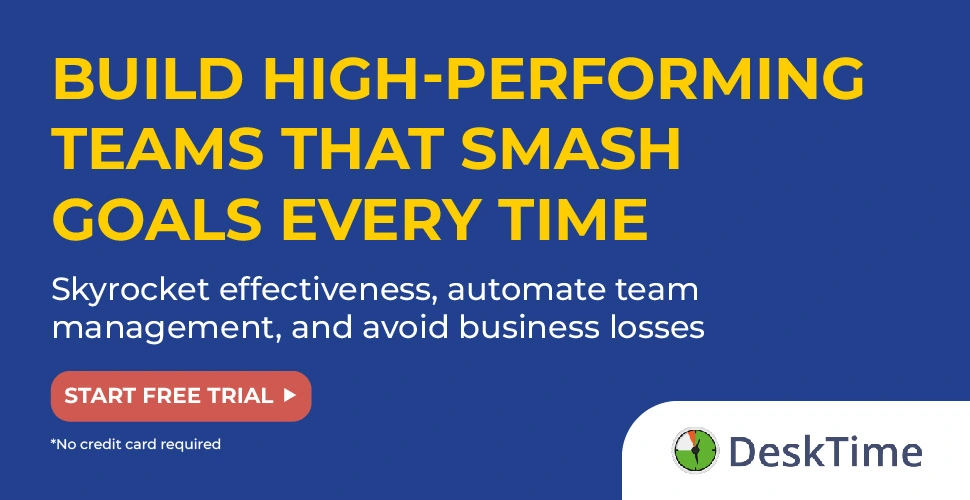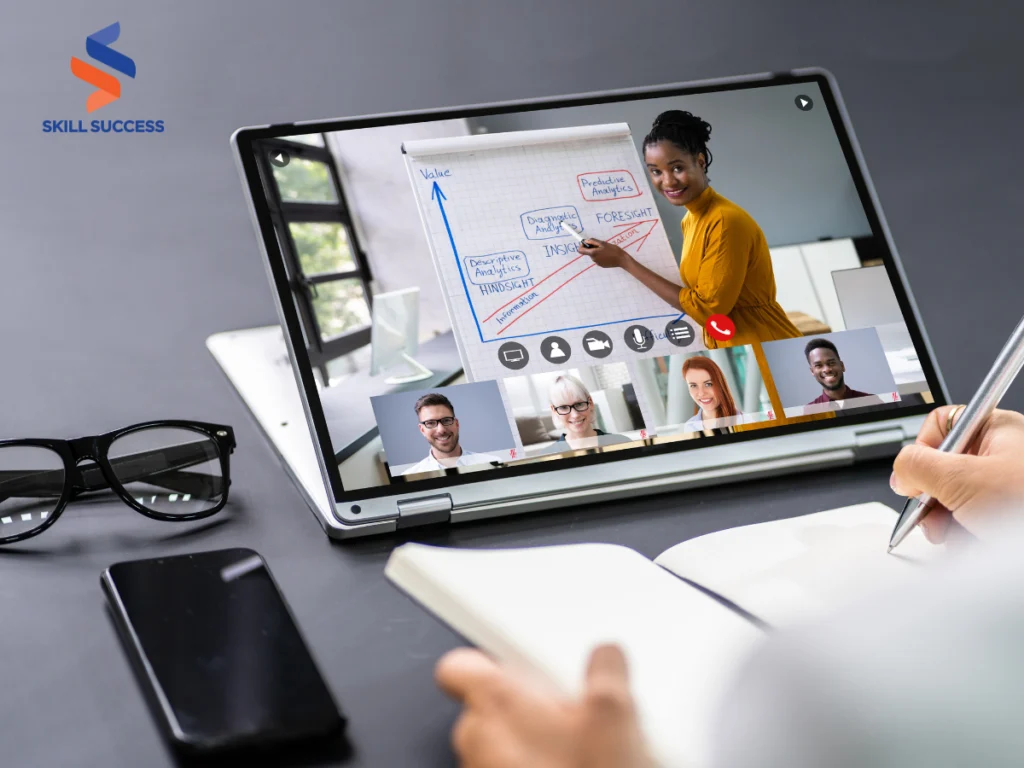Employee training is a crucial element in fostering organizational growth and maintaining a competitive edge. According to IBM, well-trained employees can increase productivity by 10%, while organizations that invest in employee training can see a 16% increase in customer satisfaction.
Furthermore, a report from the Society for Human Resource Management found that companies with robust training programs experience 53% lower attrition rates. These statistics highlight the multifaceted benefits of effective training programs, which not only enhance employee skills and performance but also significantly improve job satisfaction and retention.
This report aims to explore the most effective training methods for 2024, including the implementation of corporate e-learning solutions. The results found here are also supported by expert opinions and studies.
Methodology
This report examines the best employee training methods for 2024, highlighting expert insights and recommendations. Through surveys, interviews and comprehensive analysis, the report provides actionable strategies for organizations to enhance their training programs.
Why Learn the Best Employee Training Methods?

Studying the best employee training methods is crucial for several reasons:
1. Enhanced productivity and performance
Effective training methods equip employees with the necessary skills and knowledge to perform their tasks efficiently. Research shows that well-trained employees are more productive and contribute to higher organizational performance.
To further boost productivity, consider using DeskTime to track time management and ensure optimal performance across your team.
2. Employee retention and satisfaction
Training and development opportunities are significant factors in employee satisfaction and retention. Employees who feel valued and see opportunities for growth are more likely to stay with their employer.
3. Adaptation to technological advances
With rapid technological advancements, continuous training ensures that employees are up-to-date with the latest tools and techniques, keeping the organization competitive.
4. Organizational growth
Training fosters innovation and adaptability, which are essential for organizational growth and responding to market changes.

Literature Review on Effective Employee Training Methods
This review explores key theoretical frameworks about contemporary employee training program practices, emphasizing the importance of aligning methods with evolving workplace needs and technological advancements.
1. Adult Learning Theory (Andragogy)
Malcolm Knowles' Adult Learning Theory, or andragogy, is pivotal in understanding how adults learn.
This theory posits that adult learners are self-directed, bring life experiences to their learning, are goal-oriented, relevancy-oriented, practical, and need to be respected as capable of self-direction. These principles suggest that training methods should:
- Encourage self-direction: Provide opportunities for learners to take control of their learning processes.
- Leverage experience: Integrate real-life experiences and practical applications into training.
- Be goal-oriented: Clearly define learning objectives that align with the learners' personal and professional goals.
- Ensure relevance: Design training content that is immediately applicable to the learners' roles.
- Respect learners: Foster a learning environment that values and leverages the expertise of adult learners.
- Facilitate practical application: Incorporate hands-on activities and real-world problem-solving.
“When we introduce new tools or processes, we pair the training with real projects that employees can work on immediately. This practical approach not only reinforces the training content but also allows team members to see the direct impact of their new skills.”
2. Experiential Learning Theory
“In my experience, a blend of experiential learning, such as simulations or case studies, combined with interactive workshops and ongoing coaching, tends to be the most effective for skill acquisition in the workplace.”
David Kolb's Experiential Learning Theory (ELT) emphasizes the importance of experience in the learning process. ELT outlines a cyclical model of learning comprising four stages:
- Concrete experience: Engaging in a new experience or reinterpreting an existing experience.
- Reflective observation: Reflecting on the experience from different perspectives.
- Abstract conceptualization: Forming new ideas or modifying existing concepts based on reflections.
- Active experimentation: Applying new ideas to the world around them to see what happens.
This theory underscores the value of immersive, hands-on training methods that allow employees to learn through doing, reflecting, conceptualizing, and experimenting.
“In my experience, building and leading Grooveshark, a key method for learning and refining new skills was through "Learning by Doing" supplemented with "Regular Reflection Sessions." This approach was particularly beneficial in a tech environment where we had to adapt quickly to emerging trends and technologies. By immersing team members in tasks slightly outside of their existing expertise, and providing real-time feedback, they not only learned new skills but also understood how these skills directly impacted our business.”
3. Constructivist Theory
Constructivist Theory, influenced by Jean Piaget and Lev Vygotsky, asserts that learners construct knowledge through experiences and social interactions. Key principles include:
- Active learning: Engaging learners in activities that require critical thinking and problem-solving.
- Collaboration: Encouraging social interaction and collaboration to build knowledge.
- Scaffolding: Providing support structures to assist learners in achieving higher levels of understanding.
- Contextual learning: Ensuring learning is contextual and relevant to real-world scenarios.
Constructivist approaches in training emphasize interactive, collaborative, and contextually meaningful activities that align with the learners' existing knowledge and experiences.
4. Cognitive Load Theory
John Sweller's Cognitive Load Theory (CLT) focuses on the mental effort required to learn new information. CLT suggests that effective training should:
- Manage intrinsic load: Simplify complex information to align with the learners' cognitive capabilities.
- Reduce extraneous load: Minimize unnecessary cognitive distractions that do not contribute to learning.
- Optimize Germane load: Design activities that enhance the processing and construction of schemas.
Applying CLT to training methods involves structuring content to avoid cognitive overload, using clear and concise instructions, and incorporating supportive tools and resources.
Different Types of Training Methods for Employees

Over the years, training methods have evolved from traditional classroom-based sessions to more dynamic and technology-driven approaches. Each method offers unique advantages and caters to different learning styles and organizational needs.
Below, we explore various training methods that can help organizations develop their workforce and achieve their goals.
1. On-the-Job Training (OJT)
“In my robust experience as the President of TechTrone IT Services, where I oversee an array of IT networking and security projects, I've found that a blend of structured on-the-job training (OJT) paired with strategic certifications is the most effective method for fostering technical mastery. At TechTrone, new team members immediately engage with ongoing projects under the supervision of experienced professionals. This not only familiarizes them with their role contextually but also integrates them into our company culture of proactive problem solving and client-focused solutions.”
On-the-job training provides hands-on experience in the work environment, allowing employees to learn by doing instead of just reading theories from training materials.
It offers immediate application of skills and real-world experience, making it a cost-effective method. However, it can be disruptive to operations and relies heavily on the quality of the trainer.
Solutions:
- Develop comprehensive, standardized training plans with clear objectives and steps.
- Provide checklists and instructional guides to ensure systematic coverage of skills and tasks.
- Choose trainers with excellent communication and mentoring skills.
- Implement programs to equip trainers with teaching techniques and feedback skills.
- Plan training during low-demand periods to reduce disruptions.
- Use job rotation and shadowing to balance operational needs and training.
“When it comes to the team, my approach typically involves shadowing. Brand work is notoriously hard to document thoroughly, and even if you do manage to do it, the documentation will never truly reflect what it looks like in practice. To bridge this gap, we implement a shadowing system to ensure that anyone coming in to a new role gets a feel of how their job is supposed to be done. It also allows us to identify any possible blind spots with the help of observations and suggestions from the person who is being shadowed.”
“Job shadowing is instrumental as it provides firsthand experience and context. Secondly, microlearning through short, focused lessons allows for easier understanding and immediate application. Thirdly, role-playing scenarios can help employees learn how to react in realistic situations. Lastly, the mentoring system fosters personal growth and a clearer understanding of job roles.”
- Utilize simulation software for controlled, risk-free practice.
- Provide mobile tools for reviewing procedures and accessing instructional content.
- Schedule check-ins and progress reviews for ongoing support.
- Implement systems for trainees to share experiences and suggest improvements.
2. Classroom-based training
Classroom-based features traditional instructor-led training sessions in a structured setting. This method allows for direct interaction with instructors and peer collaboration.
While it provides a controlled learning environment, it may lack flexibility in scheduling and might not cater to all learning styles.
Solutions:
- Combine classroom sessions with online modules to offer flexibility and cater to different learning preferences.
- Offer multiple session times, including evenings and weekends, to accommodate various schedules.
- Use a mix of lectures, group activities, discussions, and multimedia to engage different learning styles.
- Regularly gather feedback from participants to improve and adapt training methods to better meet their needs.
3. Online training and e-learning
Online training and e-learning offer web-based courses and modules that can be accessed remotely. This method provides flexibility, scalability, and often more cost-effectiveness, allowing for self-paced learning. However, it requires self-discipline, may face technical issues, and has less face-to-face interaction.
Solutions:
- Provide clear schedules, deadlines, and regular reminders to help learners stay on track.
- Offer robust technical support and resources to resolve issues quickly.
- Incorporate interactive elements like quizzes, discussions, and virtual classrooms to enhance engagement.
- Combine online modules with occasional in-person or live virtual sessions for a balanced approach.
- Use online forums and group projects to foster peer interaction and collaboration.
4. Blended learning
Blended learning combines in-person and online training, leveraging the benefits of both methods. It offers diverse learning experiences and increased engagement.
Designing and managing blended learning programs can be complex and requires coordination between online and in-person components.
Solutions:
- Develop a cohesive plan that aligns online and in-person activities with clear objectives.
- Ensure seamless scheduling and transitions between online and in-person sessions.
- Use a unified learning management system (LMS) to centralize materials, track progress, and facilitate communication.
- Provide training for instructors on effectively delivering and managing blended learning.
- Implement regular feedback loops to continuously improve the blended learning experience.
5. Mentorship and coaching
Mentorship and coaching provide personalized guidance from experienced professionals to less experienced employees. This method enhances career development and fosters strong professional relationships. However, it can be time-consuming and depends on the availability and willingness of mentors.
Solutions:
- Implement a structured mentor matching program to align mentees with suitable mentors based on skills and goals.
- Encourage flexible meeting schedules to accommodate both mentors and mentees.
- Provide training for mentors to enhance their coaching skills and effectiveness.
- Offer resources and tools to assist mentors and mentees in managing their time and relationships.
- Recognize and reward mentors for their contributions to encourage participation and commitment.
“As a real estate investor, I've found that receiving mentorship in addition to practical experience is the best way to acquire new job-related skills or knowledge. Learning and retention can be accelerated, in my experience, by actively participating in real-life circumstances and shadowing seasoned experts.”
2. Classroom-based training
Classroom-based features traditional instructor-led training sessions in a structured setting. This method allows for direct interaction with instructors and peer collaboration.
While it provides a controlled learning environment, it may lack flexibility in scheduling and might not cater to all learning styles.
Solutions:
- Combine classroom sessions with online modules to offer flexibility and cater to different learning preferences.
- Offer multiple session times, including evenings and weekends, to accommodate various schedules.
- Use a mix of lectures, group activities, discussions, and multimedia to engage different learning styles.
- Regularly gather feedback from participants to improve and adapt training methods to better meet their needs.
3. Online training and e-learning
Online training and e-learning offer web-based courses and modules that can be accessed remotely. This method provides flexibility, scalability, and often more cost-effectiveness, allowing for self-paced learning. However, it requires self-discipline, may face technical issues, and has less face-to-face interaction.
Solutions:
- Provide clear schedules, deadlines, and regular reminders to help learners stay on track.
- Offer robust technical support and resources to resolve issues quickly.
- Incorporate interactive elements like quizzes, discussions, and virtual classrooms to enhance engagement.
- Combine online modules with occasional in-person or live virtual sessions for a balanced approach.
- Use online forums and group projects to foster peer interaction and collaboration.
4. Blended learning
Blended learning combines in-person and online training, leveraging the benefits of both methods. It offers diverse learning experiences and increased engagement.
Designing and managing blended learning programs can be complex and requires coordination between online and in-person components.
Solutions:
- Develop a cohesive plan that aligns online and in-person activities with clear objectives.
- Ensure seamless scheduling and transitions between online and in-person sessions.
- Use a unified learning management system (LMS) to centralize materials, track progress, and facilitate communication.
- Provide training for instructors on effectively delivering and managing blended learning.
- Implement regular feedback loops to continuously improve the blended learning experience.
5. Mentorship and coaching
Mentorship and coaching provide personalized guidance from experienced professionals to less experienced employees. This method enhances career development and fosters strong professional relationships. However, it can be time-consuming and depends on the availability and willingness of mentors.
Solutions:
- Implement a structured mentor matching program to align mentees with suitable mentors based on skills and goals.
- Encourage flexible meeting schedules to accommodate both mentors and mentees.
- Provide training for mentors to enhance their coaching skills and effectiveness.
- Offer resources and tools to assist mentors and mentees in managing their time and relationships.
- Recognize and reward mentors for their contributions to encourage participation and commitment.
“As a real estate investor, I've found that receiving mentorship in addition to practical experience is the best way to acquire new job-related skills or knowledge. Learning and retention can be accelerated, in my experience, by actively participating in real-life circumstances and shadowing seasoned experts.”
6. Workshops and seminars
“We often start with structured workshops to introduce new concepts, followed by practical, project-based tasks that allow team members to apply these concepts in real scenarios. This approach not only enhances understanding but also retains engagement, as it allows individuals to see the immediate impact of what they're learning. For instance, after a session on a new software tool, we might have a mini-hackathon where our teams use the tool to solve actual problems they face in their workflows. This method helps cement the knowledge and shows how it can be used to enhance productivity.”
Workshops and seminars offer short, intensive educational sessions focused on specific topics or skills. These sessions are interactive and can address current issues or trends. The short duration of workshops and seminars may limit the depth of learning, making them less suitable for comprehensive training.
Solutions:
- Provide additional materials and resources for further learning after the session.
- Distribute pre-workshop reading or assignments to prepare participants.
- Schedule follow-up activities, such as projects or discussion groups, to reinforce learning.
- Choose the right training and ensure content is highly focused and relevant to maximize the impact within the limited time.
- Use skilled facilitators to deliver content effectively and engage participants actively.
“Here at Localizely, we've discovered that the best way to learn is by diving into actual projects while also adhering to a structured learning plan. We're encouraging our team to tackle real-world challenges, while ensuring they have access to an extensive selection of courses and resources. This combination allows everyone to not only apply their new skills in tangible ways but also to deeply understand and retain them. Additionally, we regularly hold workshops and tech talks, fostering a culture where knowledge sharing is an integral part of our daily routine.”

Survey Results on the Types of Employee Training Methods for 2024
The survey on the best employee training methods included respondents from a wide range of roles:
- 10.5% entry-level
- 10.5% freelancers/contractors
- 21% in managerial roles
- 21% mid-level, and
- 26.5% senior-level
Interestingly, 10.5% of respondents provided responses that didn’t fit neatly into these categories, adding an element of unpredictability and highlighting the diversity of modern job roles.
Additionally, the survey on the best employee training methods included respondents distributed across various company sizes:
- 22.1% from enterprises (1001+ employees)
- 5.6% from medium-sized companies (51-250 employees), and
- 66.7% from small companies (1-50 employees)
- 5.6% not specifying their company size
The overall data provides a broad perspective on the best training methods, considering diverse roles and company sizes. This enhances the understanding of effective training strategies across different organizational contexts and levels of responsibility.
1. How important do you believe ongoing training and development are for your professional growth and career advancement within the company?

The survey on the importance of employee training methods revealed the following:
- 33.3% of respondents found it important
- 11.1% somewhat important, and
- 55.6% very important
This indicates a high overall recognition of the significance of effective training methods among the participants.
2. How do you prefer to receive training for your job?

- 61.1% of respondents favored online courses/modules
- 27.7% combination of all methods
- 5.6% preferred in-person workshops/seminars
- 5.6% selected webinars/virtual training sessions, and
This indicates a strong preference for online training formats among the participants.
Sign up at Skill Success Teams, where your employees can access a wide range of online courses designed for their professional growth. Empower your team with the skills they need to excel!
3. What factors influence your decision to participate in training sessions?

The survey on factors influencing the choice of training methods revealed that:
- 44.4% of respondents prioritized the potential for skill development
- 16.7% emphasized relevance to their job role
- 16.7% selected combination of all factors
- 11.1% valued the convenience of scheduling, and
- 11.1% focused on the quality of trainers/instructors
This indicates that skill development is the most significant factor for participants when choosing training methods.
4. What challenges or barriers do you encounter when participating in training sessions?

The survey on challenges or barriers encountered when participating in training sessions revealed that 83.3% of respondents identified scheduling conflicts as a significant issue
The remaining 16.7% specified lack of resources, insufficient post-training support, technical issues, and irrelevance to the job role.
This indicates that scheduling conflicts are the predominant barrier for most employees when it comes to participating in training sessions.
Additionally, the same respondents suggested several ways to improve the company's training programs:
- Offer on-site training
- Provide diverse options and subjects
- Incorporate more tests and exams
- Shorten class durations
- Ensure uninterrupted study time
- Use AI for better searching and incentives for completion
- Implement growth-focused training
- Develop internal courses for specific needs
- Offer financial aid or pay for courses
These insights highlight the need for flexibility, relevance, and support in enhancing training programs.
Effective Training Methods for 2024

While many traditional training methods remain effective, the rapid evolution of technology and the workforce requires organizations to adopt innovative approaches.
Here are some of the most effective training methods for 2024:
1. Personalization
Tailoring training programs to individual employee needs and career goals increases engagement and effectiveness. Personalized training ensures that employees receive relevant and meaningful development opportunities.
and meaningful development opportunities. “Because we all have different learning styles it is essential to offer an approach in training that fits our needs. To provide an example, the visual learners may gain from the videos and the kinesthetic learners may prefer to do practical work. The training method should be adjusted to individual learning styles and the specifics of conveying the knowledge or the information.”
2. Technology integration
Utilizing advanced technologies such as artificial intelligence (AI), virtual reality (VR), and augmented reality (AR) creates immersive learning experiences. These technologies can enhance training effectiveness by providing realistic simulations and interactive content.
3. Continuous learning
Promoting a culture of continuous learning through microlearning modules and just-in-time training resources ensures that employees can access information when they need it. Continuous learning helps keep skills up-to-date and relevant.
“We are a remote company that understands the importance of continuous learning to ensure job satisfaction related to one's job. We offer all our employees a certain budget to gain new skills in the relevant fields to ensure they are staying up to date with industry developments.”
4. Data-driven approaches
Leveraging data analytics to assess training effectiveness, track progress, and refine programs based on measurable outcomes allows organizations to make informed decisions. Data-driven approaches help optimize training investments and demonstrate ROI.
5. Collaborative learning
Encouraging collaboration and knowledge sharing through social learning platforms and peer-to-peer networks fosters a community of learning. Collaborative learning enhances employee engagement and helps build a supportive learning environment.
“I've found that one of the most effective methods for learning new skills or information is through iterative, hands-on project work complemented by peer review sessions. Engaging in active development projects allows our team members to apply new techniques in a real-world setting, providing a stronger grasp of both the technology and its practical implications.”
6. Microlearning
Implement bite-sized training modules that focus on specific skills or knowledge areas. Microlearning is convenient and effective, fitting into employees' busy schedules and improving knowledge retention.
7. Adaptive learning
Use AI-driven platforms to adapt training content based on the learner's performance and preferences. Adaptive learning personalizes the training experience, ensuring that employees receive the right level of challenge and support.
8. Virtual classrooms
Conduct live, interactive training sessions online. Virtual classrooms combine the benefits of in-person training with the convenience of remote access, allowing for real-time interaction and engagement.
9. Scenario-based training
Create realistic scenarios and simulations that employees must navigate. Scenario-based training helps develop problem-solving skills and prepares employees for real-world challenges by placing them in lifelike situations.
“In my career as an orthopedic surgeon, I've found that the most effective method for learning new skills or absorbing information in the medical field is through immersive, scenario-based training. During my fellowship at the Mississippi Sports Medicine and Orthopedic Center, learning was hands-on with real-life case studies, under the expert guidance of Dr. Felix "Buddy" Savoie. This approach allowed me to directly apply theoretical knowledge in surgical techniques, significantly enhancing my learning curve and surgical skills.”
10. Performance support systems
Provide on-the-job aids and resources that employees can access as needed. Performance support systems ensure that employees have the tools and information they need to perform tasks effectively, enhancing productivity and reducing errors.
11. Peer coaching
Establish peer coaching programs where employees support and learn from each other. Peer coaching fosters a collaborative learning environment and helps build strong interpersonal relationships.
“Applying the newly learned skill is the best approach to retrain it. But personally, I prefer teaching or discussing the learned skills. Teaching taps into a unique corner in your brain where you have to break down and truly understand the nuance of the skill.”
12. Cross-training
Encourage employees to learn multiple roles within the organization to promote long term benefits for the company. Cross-training enhances workforce flexibility, improves team collaboration, and prepares employees for career advancement.
13. Learning Management Systems (LMS)
Implementing robust LMS platforms to deliver, track, and manage training programs. LMS platforms enable personalized learning paths, automate administrative tasks, and provide detailed analytics on training effectiveness.
Use a powerful LMS like Skill Success to simplify your training management. Equip your employees with customized learning paths and access comprehensive analytics on training impact.
14. Game-based learning
“We've tried using games in our training programs here at BeamJobs, and the results have been amazing. For example, to help new team members get started, we made a point-based system where they could earn badges and virtual rewards for finishing training modules, reaching milestones, and showing they were good at learning new skills.”
Use game elements and gamification techniques to make training engaging and fun. Game-based learning motivates employees and enhances knowledge retention through interactive and competitive elements.
“As someone deeply involved in the real estate industry, I've found that embracing innovative training methods can significantly benefit agents. Take, for example, real estate escape rooms, an unconventional yet highly effective approach. These immersive experiences offer invaluable opportunities for agents to practice critical skills in a dynamic and engaging environment.”
15. Knowledge sharing platforms
Implement platforms where employees can share insights, best practices, and solutions. Knowledge sharing promotes continuous learning and leverages collective expertise within the organization.
Future Trends in Employee Training Methods

Looking ahead, several key trends are expected to shape the future of employee training.
1. Advancements in training technologies
Artificial Intelligence (AI) and Machine Learning: AI and machine learning will revolutionize employee training by creating highly personalized learning experiences. For example, AI-powered chatbots can offer instant support and feedback, enhancing the learning process.
- Virtual Reality (VR) and Augmented Reality (AR): These technologies are particularly useful for complex or high-risk training scenarios, such as medical procedures or equipment handling, where hands-on practice is crucial.
- Data analytics: The integration of data analytics into training programs will enable organizations to measure training effectiveness more accurately.
With Skill Success, you can leverage detailed analytics to monitor your team's progress and identify areas for improvement. Use these insights to tailor your training programs for maximum efficiency and impact.
2. Remote and hybrid training models
Blended learning, which combines in-person and online training, will become more prevalent. This approach allows employees to benefit from the best of both worlds—face-to-face interaction and the convenience of remote learning.
3. Emphasis on continuous learning and development
- Continuous learning: As the pace of technological and industry changes accelerates, continuous learning will become a core organizational value.
- Microlearning modules: Delivered content in short, digestible chunks, it will support just-in-time learning and help employees stay updated with the latest skills and knowledge.
- Lifelong learning: Organizations will need to foster a culture that encourages lifelong learning. This involves providing employees with ongoing development opportunities, such as professional courses, certifications, and access to learning resources.
4. Focus on soft skills and leadership development
- Soft skills: The demand for soft skills, such as critical thinking, creativity, and emotional intelligence, will increase. Training programs will need to focus on developing these skills to prepare employees for the future workplace.
- Leadership development: Organizations will invest in leadership training programs that emphasize strategic thinking, change management, and inclusive leadership practices.
Explore the Leadership Prodigy learning path course to gain essential soft skills and become a visionary leader. Empower your team and drive your organization forward with cutting-edge leadership techniques.
5. Integration of Social Learning
- Social learning: Online forums, discussion boards, and collaborative platforms will facilitate social learning, allowing employees to learn from each other’s experiences and insights.
- Mentorship programs: Structured mentorship programs will support social learning by pairing less experienced employees with seasoned professionals. This approach fosters knowledge transfer, professional growth, and a sense of community within the organization.
With the myriad of new techniques and training methods available, it’s crucial for employees to strike the right balance. Colt Agar’s insights offer valuable and impactful guidance to help them achieve this harmony. You can also share the same with your team.
“Learning is necessary, but too much leveling up in your off-time can be detrimental to your progress. Your career gets better by doing the job well, and too much after-work training can take away focus and energy to do the best you can.”
Skill Success Expert Insights on the Best Employee Training Methods
Drawing from extensive experience in facilitating corporate training, I've discovered that minimal time should be spent on explaining theories. Instead, it's far more effective to provide real case scenarios infused with relevant studies and theories. This approach prevents employees from getting bored with theoretical content and keeps them engaged.
Incorporating activities that deviate from their daily routines is crucial. For instance, conducting debates on the training topic or simulating real scenarios for participants to act out can be highly effective. These methods not only make the sessions more enjoyable but also significantly enhance the learning experience.
Participants often express how much they enjoy these interactive sessions, and the hands-on approach ensures they absorb and retain the information better.
Recommended Courses for Employee Training
1. Management: Practical Ways To Motivate And Engage Your Team
This course is ideal for managers and leaders aiming to boost team motivation and engagement with practical, actionable strategies that can be implemented immediately. It excels in providing real-world solutions to improve leadership abilities, facilitate change, and align personal and organizational goals for better team performance.
The course's focus on practical application, including case studies and hands-on techniques, makes it particularly effective and easy to apply in the workplace.
I found the course valuable for its straightforward, effective strategies that can enhance leadership skills and improve team dynamics.
Who is this course for?
Designed for supervisors, managers, leaders, business owners, and entrepreneurs in business, IT, and finance who seek to maximize their and their team's potential.
TAKE THIS COURSE2. Developing Emotional Intelligence In Teams
This course is perfect for those looking to enhance emotional intelligence within their team, whether small or large. It offers valuable insights into improving interpersonal relationships and team dynamics. It provides comprehensive coverage on how emotional intelligence can lead to better team outcomes, manage change, and handle conflict effectively. It focuses on practical strategies to develop emotional resilience and social skills.
Its emphasis on practical activities and the DISC behavioral styles makes it stand out. These elements help participants understand and apply emotional intelligence concepts to real-world team interactions.
I found the course particularly insightful for its focus on building emotional resilience and understanding different behavioral styles. The practical approach ensures that the lessons are not just theoretical but can be applied directly.
Who is this course for?
This course is suitable for anyone interested in developing emotional intelligence within their team. It supports those looking to improve interpersonal relationships, understand behavioral styles, and build a more cohesive team.
TAKE THIS COURSE3. Team Building: How To Build A Team Of Rock Stars
The course covers essential aspects of team building, including leadership attitude, motivation techniques, hiring practices, performance reviews, and coaching. It’s structured to help you build a cohesive, high-performing team.
Its focus on actionable steps, from hiring the right people to conducting effective performance reviews, sets this course apart. The emphasis on creating a culture of innovation and high performance makes it particularly valuable.
I found this course incredibly useful for its comprehensive approach to team building. It equips leaders with the skills needed to motivate, coach, and develop their teams effectively.
Who is this course for?
This course is perfect for anyone focused on creating a high-performance, innovative team culture. It’s suitable for new leaders, HR professionals, managers, and business owners looking to grow their personal and professional careers.
TAKE THIS COURSEFrequently Asked Questions
1. What are the most effective employee training methods for 2024?
Personalized learning, technology integration, and continuous learning are among the top methods.
2. Why is personalized training important?
It ensures training is relevant and engaging, improving retention and application of skills.
3. How can technology enhance employee training?
Technologies like AI, VR, and AR create immersive and interactive learning experiences.
4. What is continuous learning?
An ongoing approach to training that includes microlearning modules and just-in-time resources.
5. How can data analytics improve training programs?
By tracking progress, assessing effectiveness, and refining programs based on measurable outcomes.

Key Takeaways
The best employee training methods for 2024 leverage technology and innovation to create engaging and effective learning experiences. Organizations that invest in these methods will be better positioned to develop their workforce and achieve strategic objectives. By following expert recommendations and learning from successful case studies, companies can implement training programs that drive performance and growth.
To stay ahead of the curve and implement these cutting-edge training methods, partner with Skill Success Teams. After helping over 700,000 students learn new skills, we are expanding our mission to help businesses upskill their teams. With unlimited access to over 5,000 online courses and more, Skill Success Teams offers a comprehensive solution for your training needs. Our easy-to-use platform ensures a great learning experience, and investing in upskilling your team members assures a great ROI.

